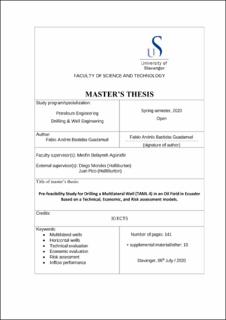| dc.description.abstract | The oil and gas industry is constantly in search of developing new technologies that allow to reduce operational costs and maximize the recovery of hydrocarbons in onshore and offshore fields. There are several alternatives that can be selected, among them are multilateral wells, which is an emerging technology as a result of an evolution of horizontal wells. Multilateral technology has shown several benefits in the development of oil and gas fields, such as increase the production of hydrocarbons, generate significant savings, potentially increase profits, and has high flexibility of applications in different types of reservoirs which it may be applied. Based on the benefits mentioned, the feasibility of drilling a TAML Level 4 multilateral well in an oil field in Ecuador is analyzed in this research work.
Therefore, to determine the feasibility or not of drilling a multilateral well in Ecuador, this master's thesis comprises a technical, economic and risk analysis, which are based on the evaluation and comparison of the performance of a multilateral well (dual lateral stacked) against the performance of a horizontal well that produces oil through 2 different sections at the same time (vertical and horizontal section).
Based on the technical analysis results, it can be concluded that drilling a Level 4 multilateral well would increase production 2.85 times compared to a horizontal well system. Different economic performance indicators like NPV, FCF, PI, show that the multilateral well is the most profitable option compared to the horizontal well. Furthermore, the risk assessment performed using deterministic decision tree model, which is based on the results of the economic analysis and quantifying the risks involved in the drilling stage, shows that by drilling a TAML Level 4 multilateral well the highest EMV can be achieved, even though it is the option with the highest risks involved.
The study demonstrates the feasibility of drilling a TAML Level 4 multilateral well in the Ecuadorian oil field, providing benefits from both a technical and economic point of view. This is also supported by the different field case studies analyzed that indicate a 100% success rate. | en_US |
